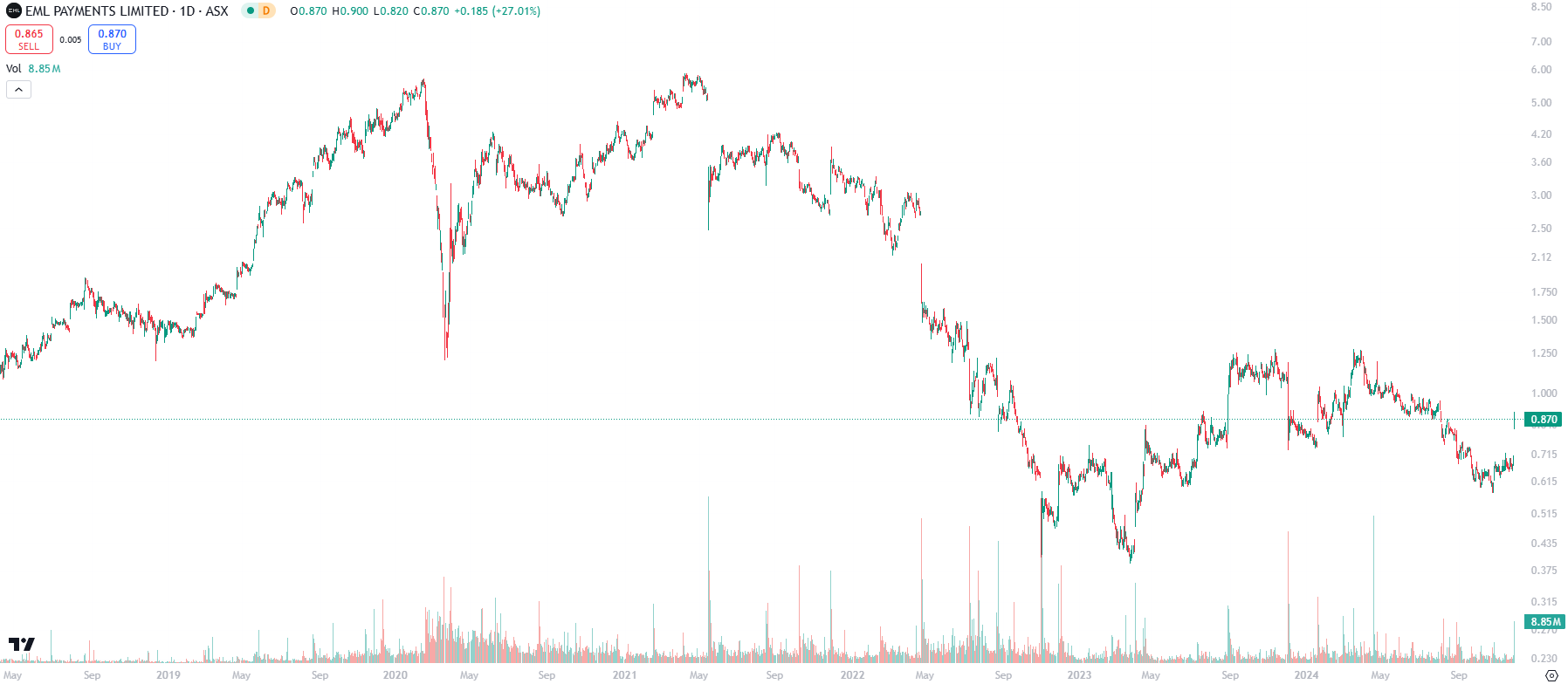EML Payments (ASX:EML): Investors are optimistic its onwards and upwards from here, but its a long way back to the top

EML Payments (ASX:EML) investors had a good day yesterday with shares rising 25% after a trading update. The company reaffirmed its FY25 guidance of $54-60m EBITDA, and it recorded very strong revenue and EBITDA growth figures for the September quarter. Investors are happy that the company has delivered on previous promises to turn things around and that it finally got out of its Sentenial business a few months ago. How did things get to this point and what is next?
EML Payments’ past (ASX:EML)
EML Payments was founded in Brisbane in 2003. It has software that provides payment services and user experience services to banks, corporates, fintechs, government and other private industries. Its specialty is enabling salary packaging card spending and it has a significant market presence in enabling non-bank digital lending disbursement and government disbursements for stimulus and other disaster relief.
By 2021, the company had operations in 28 countries and has nearly 500 staff. EML was on track to record $20bn in transactions (Gross Debit Volume or GDV), operated in 28 countries and it was EBITDA and NPAT positive – making $28.1m and $13.2m respectively. Then, things took a turn for the worse. The company’s share price fell by over 70%, thanks to regulatory issues in Ireland and a profit downgrade.

EML Payments (ASX:EML), share price chart, log scale (Source: TradingView)
EML’s payments platform was first red-flagged by Ireland’s Central Bank (CBI) in May 2021 and ever since, it has been working to resolve the issues – and there were a lot of them. These included the composition of the board, the governance methodology and process, as well as compliance progresses. It had to overhaul its entire European leadership team.
News that Britain’s regulator had issues in 2022 was arguably the last thing the company needed. These issues have been resolved now that the company sold the platform for EU32.75m. Obviously it is a lot less than it would have received not just before these issues, but even pre-Brexit. The company only entered Ireland after Brexit, buying Prepaid Financial Services (PFS) in that country.
Troubles continued post-pandemic with then chairman Peter Martin being thrown out after investor anger that he knocked back takeover offers from Bain and Nuvei Corp, a tenure of Texas-based activist investor firm Alta Fox appointing multiple members to the board, CEO Tom Cregan being replaced by Emma Shand and Shand only lasting 10 months before leaving. Things came to a head in November 2023 when the company told investors it couldn’t satisfy Irish regulators, and that its card services unit was losing $20 million a year.
Even 2024 has not been clear of dramas. Chairman Luke Bortoli, a former Afterpay executive, spent over $100,000 in personal expenses on a credit card, believing there directors approved to do this in lieu of receiving director fees, then left.
Signs of life?
Current CEO Ron Hynes joined in June 2024. Hynes was a former Mastercard executive and is based in the US. The company cashed out of its Sentenial business, found up its Irish business PCSIL and was finally able to satisfy UK regulators of the issues it had raised. The continuing business made $217.3m in revenue, up 18%, and $49m in EBITDA, up 34%. For FY25, it has guided to $54-60m EBITDA and for ‘double-digit transaction revenue growth by FY27’.
At its AGM, the company has told investors it has a TAM of $716bn in single use gift cards and $1.06tn in General Purpose Reloadable cards (including digital wallets). Respectively these markets are forecast to grow at a CAGR of 17% and 19%. On top of this, FY25 has begun well with 7% growth in GDV (Gross Debit Volume), 12% higher revenue and 46% higher EBITDA. The first of these figures was A$5.9bn.
Conclusion
You might be forgiven for thinking the digital payments space has little growth room left – especially as cash is used a lot less in Australia. But globally, digital payments are only $8tn whilst cash is $38tn. The latter is declining 4% per year but the former is growing by 21%. And although simple payments are reasonably serve, more complex use cases like employee benefits remain underserved. As an end-to-end embedded payments issuer, EML is well positioned for growth in the years ahead. It appears to have put the worst of the past few years behind it, and is set for a new era of growth.
What are the Best ASX Stocks to invest in right now?
Check our buy/sell tips
Blog Categories
Get Our Top 5 ASX Stocks for FY26
Recent Posts
Develop Global Wins $200m OceanaGold Contract- What It Means for Investors
Develop Global (ASX: DVP) climbed 4% to A$4.36 on Friday after securing a A$200 million underground development contract with global…
Nova Minerals Drops 14% on $20m Capital Raise- Buy or Avoid?
Nova Minerals (ASX: NVA) dropped nearly 14 per cent to A$0.90 following the announcement of a US$20 million (approximately AUD…
WiseTech (ASX:WTC) Rises After Richard White Cleared of Misconduct – Should You Buy the Dip?
WiseTech Global (ASX: WTC) climbed 3 per cent to A$70.18 on Friday after founder and Executive Chairman Richard White was…



